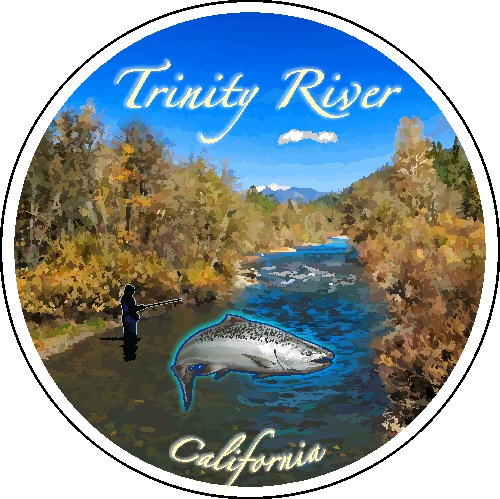Fish and Wildlife
The Trinity River Watershed is home to over 200 different wildlife species, 17 of which are considered rare including amphibians, reptiles, birds, and mammals. Most notably, the Trinity River and its tributaries support important populations of chinook salmon, coho salmon, and steelhead trout. These fish are an invaluable cultural resource to native tribes and people of the Trinity River basin, and have been since time immemorial.
Salmon and steelhead are anadromous, meaning they spend part of their lives in both freshwater and saltwater. Salmon and steelhead are born in freshwater, then migrate to the ocean for much of their adult life, before returning to the stream where they were born to reproduce (spawn). Salmon die after spawning, while steelhead can go through multiple spawning cycles in their lifetime. After they die, salmon and steelhead provide important marine nutrients to the river ecosystems that benefit other fish, wildlife, and forests.
Explore The Trinity River Fish and Wildlife Species
Coho salmon
(Oncorhynchus kisutch)
Coho in the Trinity River basin are part of the Southern Oregon/Northern California Coast coho population, which is listed as Threatened under the Endangered Species Act. Coho are smaller than chinook salmon, averaging 2 feet in length! Ocean coho are silver, lending them the nickname “silver salmon.” However, if you see coho in the river, they will probably be red!

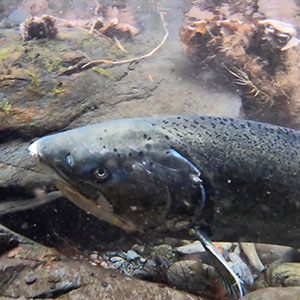
Chinook salmon are the largest Pacific salmon species, which likely earned them the name “king salmon.” They average 2.3 feet long but the largest chinook on record is over 4 feet long! Chinook have irregular-shaped black spots on their back, dorsal fin, and tail fin. They are generally green, tan, or brown once they reach the streams in their spawning phase. Chinook also have distinctive black gums. There are two runs of Chinook salmon in the Trinity River basin, fall and spring. Fall chinook are the largest run of salmon in the Trinity River. Spring chinook have been in widespread decline and the Trinity River is one of the last rivers in California supporting a spring chinook run.
Chinook salmon
(Oncorhynchus tshawytscha)
Steelhead trout
(Oncorhynchus mykiss)
Steelhead and rainbow trout are actually the same fish! Some rainbow trout, known as resident rainbow trout, live in freshwater their whole lives while others migrate to the ocean where they become steelhead. When these fish return they are much bigger and more silvery than their resident counterparts. Steelhead are on average 2 feet in length but can grow well over 3 feet. Steelhead have small black dots on their back, dorsal, and tail fins. They also have distinctive, all white mouths.

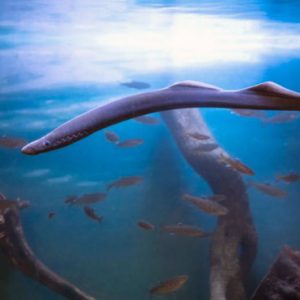
Pacific lamprey are long, slender, eel-like fish generally reaching an average of 1-2 ft in length! Lamprey are the oldest fish species in the Trinity River, with populations dating back 450 million years in North America! Lamprey are jawless fish and have a round sucker mouth that they use to feed on blood and nutrients from other fish species, including salmon. But don’t let their appearance fool you – lamprey are harmless to humans!
Pacific lamprey
(Entosphenus tridentatus)
Green sturgeon
(Acipenser medirostris)
Green sturgeon populations have persevered in the rivers of North America for the last 200 million years! However, only two vulnerable populations remain in California. The northern distinct population segment inhabits the Klamath, Trinity, and Eel rivers and is listed as a species of concern. The decline in green sturgeon can largely be attributed to habitat loss and degradation. Green sturgeon are ancient giants in the river. Adult green sturgeon can live to be over 70 years old and average 4.5-6.5 feet in length with some mature adults reaching lengths over 8.5 ft long! Sturgeon are known as benthic-feeders, using their toothless mouth to suck up macroinvertebrates, crustaceans, and smaller fish from the bottom of rivers and the seafloor. It is rare to catch a glimpse of these fish in the river as they prefer to stay in deep, swift water.
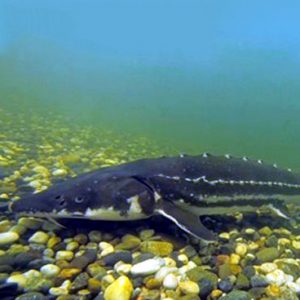
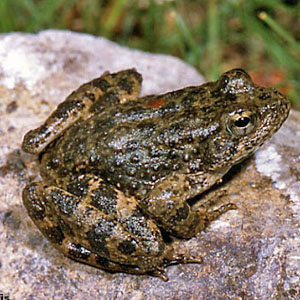
Foothill yellow legged frogs are listed under the California Endangered Species Act across most of the state, with the exception of northwestern California where in general, populations are prolific! These frogs lay their eggs in masses in May and June, with an average of 900 eggs per mass. They can be quite well camouflaged so keep an eye out along river bars and in shallow, flowing water!
Foothill Yellow Legged Frog
(Rana boylii)
Western Pond Turtle
(Actinemys marmorata)
Western pond turtles are the only species of turtle found in the Trinity River watershed! They are most active in spring and summer, when they are generally seen sunning along rivers, creeks, lakes, and wetlands. Western pond turtles begin mating in April. Females climb onto land, sometimes hundreds of feet from the water, to dig their nests and lay their eggs.

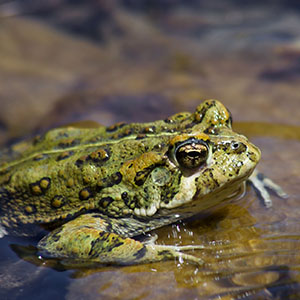
There are two subspecies of western toads, the boreal toad and California toad. Both are found in Trinity County, though they are difficult to distinguish! Western toads have a light stripe down their back and warts on their skin. When threatened, toads excrete a white poison from these warts that is toxic to some predators. Don’t worry, it isn’t harmful to humans! During spring and fall, western toads are active during the day. However, with hot summer temperatures, western toads transition to a nocturnal lifestyle.
Western Toad
(Anaxyrus boreas)
North American Beaver
(Castor canadensis)
Beavers are considered a keystone species, meaning they are an essential component to stream ecosystems! Beavers build temporary dams that create wetland and stream habitat vital for amphibians, birds, and fish. These dams also slow runoff, maintaining higher streamflow and groundwater levels during dry months.


Otters are playful creatures, often seen sliding, splashing, and flipping around in the water. River otters have thick fur that keeps them warm in the cold water of the Trinity River year-round. They can stay underwater for up to eight minutes, and have the ability to physically close their nostrils to keep water out!
North American River Otter
(Lontra canadensis)
